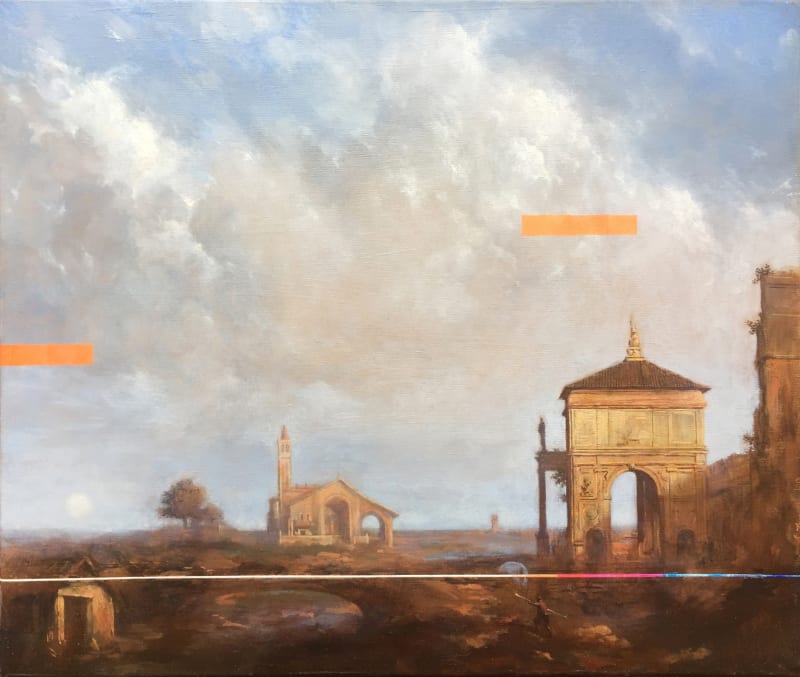As a painter, Molloy's key concern is to investigate the relevance of painting in a digitally-mediated world. The work is constructed via a process of experimenting with a series of traditional baroque-inspired themes, spliced together with over-painted elements associated with digital-based imagery. The traditional elements have been appropriated from sources within the Dutch, Spanish, Flemish and Italian baroque painting canon, combined and juxtaposed to create a series of capriccio-type fantasy scenes and miniature tondo portraits. The digital elements overlaying the traditional subject matter have been inspired by a variety of sources (C.G.I., games, image manipulation software, glitch-art, etc.). Molloy refers to these concealing elements as pentimenti.
The use of terms like 'pentimenti' refers to the underlying mark-making, choices and corrections that the painter would make during the composition of the work, usually discovered by restorers, and now, even more accurately, through the technology of reflectography. 'Pentimenti' also reveal when the painter's original work has been later over-painted, often in response to socio-political, moral or fashion imperatives or simply through complacent restoration. Thus the definitive (often canonical) work reveals itself as something which is not a solid given, but the outcome of a fluid, changing dynamic. In today's world, there is also a certain impermanence to digital images; they can be easily deleted, they succumb to degradation over time, they can be altered and manipulated as we wish. This shared impermanence of both mediums old and contemporary is key to Molloy's current area of research.
The initial access to most of the reference material explored in the paintings is found via reference books, online galleries and internet databases. With the assistance of awards from both the Thomas Dammann Jr. Memorial Trust and Fingal C.C. Molloy was offered the opportunity to travel to see examples of key works from the baroque painting canon in situ in Amsterdam, Madrid, New York and Florence. Examining the works up close allowed the artist to make mental comparisons between the original works and the digital versions, a process of analysis, deconstruction and de-composition which was then mapped on to the actual making of the artist's current body of work.
In the sometimes ludicrous extremes of the high baroque (e.g., Pietro da Cortona), viewers were offered an illusion of total immersion in a painted world echoing the immersive experience presented at any moment today through a variety of digital portals. In these works, Molloy seeks to create 'Neo-Pentimenti' deliberate corrections, alterations, interventions and degradings/decompositions of the paintings underneath. By using the over-painted elements to disturb the three-dimensional painterly illusion created by the brush-stroke, he introduces visual interventions which both repel and attract the viewer's attention, creating a new aesthetic to subvert the often didactic and singular reading that traditional figurative painting presents.
Sean Molloy has a degree in fine art and an MFA from NCAD, Dublin, He has had two solo exhibitions at the Molesworth Gallery - Landed (2018) and The Lost Estate (2020) - and one at the RHA , Neo Pentimenti (2015). His work is in many important collections, including those of the OPW and the Arts Council of Ireland.
